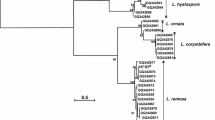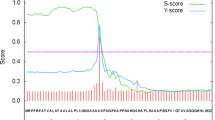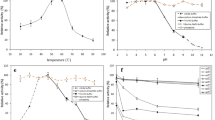Abstract
A new strain of Penicillium sp. ZH-30 that produces xylanase was isolated from soil. According to the morphology and comparison of internal transcribed spacer (ITS) rDNA gene sequence, the strain Penicillium sp. ZH-30 was identified as a strain of Penicillium oxalicum. When xylan or wheat bran was used as substrate at 30°C for 3 days under submerged cultivation, xylanase production was 5.3 and 13.3 U ml−1, respectively. The temperature and pH for optimum activity were 50°C and 5.0–6.0, respectively.






Similar content being viewed by others
References
Bedford MR, Classen HL (1992) The influence of dietary xylanase on intestinal viscosity and molecular weight distribution of carbohydrates in rye-fed broiler chick. In: Visser J, Beldman G, vanSomeren MAK, Voragen AGJ (eds) Xylans and xylanases. Elsevier, Amsterdam, pp. 361–370
Belancic A, Scarpa J, Peirano A, Diaz R, Steiner J, Eyzaguirre J (1995) Penicillium purpurogenum produces several xylanases: purification and properties of two of the enzymes. J Biotechnol 41:71–79
Biely P (1985) Microbial xylanolytic systems. Trends Biotechnol 3:286–290
Breccia JD, Castro GR, Baigori MD, Sineriz F (1995) Screening of xylanolytic bacteria using a color plate method. J Appl Bacteriol 78:469–472
Brown JA, Collin SA, Wood TM (1987) Development of a medium for high cellulase, xylanase and fl-glucosidase production by a mutant strain (NTG III/6) of the cellulolytic fungus Penicillium pinophilum. Enzyme Microbl Technol 9:355–360
Chung CT, Niemela SL, Miller RH (1989) One-step preparation of competent Escherichia coli: transformation and storage of bacterial cells in the same solution. Proc Nat Acad Sci USA 86:2172–2175
Doyle JJ, Doyle JL (1987) A rapid DNA isolation procedure for small quantities of fresh leaf tissues. Phytochem Bull 19:11–15
Erland S, Henrion B, Martin F, Glover LA, Alexander IJ (1994) Identification of the ectomycorrhizal basidiomycete tylospora-fibrillosa donk by RFLP analysis of the PCR-amplified ITS and IGS regions of ribosomal DNA. New Phytol 126:525–532
Farrell RL, Biely P, McKay DL (1996) Productionof hemicellulase by the fungus Penicillium kloeckeri. In: Srebotnik E, Messner K (eds) Biotechnology in the Pulp and Paper Industry. Proc. 6th Intern. Conf. Biotechnol. Pulp Paper Ind. Facultas-Universit∼itsvedag, Vienna, pp 485–489
Funaguma T, Naito S, Morita M, Okumura M, Sugiura M, Hara A (1991) Purification and some properties of xylanase from Penicillium herquei banier and sartory. Agric Biol Chem 55:1163–1165
Gardes M, Bruns TD (1993) ITS primers with enhanced specificity for basidiomycetes-application to the identification of mycorrhizae and rusts. Mol Ecol 2:113–118
Haas H, Herfurth E, Stoffler G, Redl B (1992) Purification, characterization and partial amino acid sequences of a xylanase produced by Penicillium chrysogenum. Biochim et Biophys Acta 1117:279–286
Kuhad RC, Singh A (1993) Lignocellulosic biotechnology: current and future prospects. Crit Rev Biotechnol 13:151–172
Law BA (2002) The nature of enzymes and their action in foods. In: Whitehurst RJ, Law BA (eds) Enzymes in food technology. Sheffield Academic Press, Sheffield, pp. 1–18
Lee SB, Taylor JW (1990) Isolation of DNA from fungal mycelia and single spores. In: Innis MA, Gelfand DH, Sninsky JS, White TJ (eds) PCR protocols: a guide to methods and applications. Academic Press, New York, USA, pp. 282–287
Maat J, Roza M, Verbakel J, Stam H, daSilra MJS, Egmond MR, Hagemans MLD, vanGarcom RFM, Hessing JGM, vanDerhondel CAMJJ, vanRotterdam C (1992) In: Visser J, Beldman G, vanSomeren (eds) Xylanases and their application in bakery, Elsevier Science, Amsterdam, The Netherlands
Miller GL (1959) Use of dinitrosalicylic acid reagent for determination of reducing sugars. Anal Chem 31:426–428
Milagres AMF, Lacis LS, Prade RA (1993) Characterization of xylanase production by a local isolate of Penicillium janthinellum. Enzyme Microb Technol 15:248–253
Mishra C, Seeta R, Rao M (1985) Production of xylanolytic enzymes in association with the cellulolytic activities of Penicillium funiculosum. Enzyme Microb Technol 7:295–299
Ninawe S, Kuhad RC (2005) Use of xylan-rich cost effective agro-residues in the production of xylanase by Streptomyces cyaneus SN32. J Appl Microbiol 99:1141–1148
Oliveira LA, Porto ALF, Tambourgi EB (2006) Production of xylanase and protease by Penicillium janthinellum CRC 87M-115 from different agricultural wastes. Biores Technol 97:862–867
Palma MB, Milagres AMF, Prata AMR, Manchilha IM (1996) Influence of aeration and agitation rate on the xylanase activity from Penicillium janthinellum. Process Biochem 31:141–145
Srinivasan MC, Rele MV (1999) Microbial xylanases for paper industry. Current Sci 77:137–142
Steiner J, Socha C, Eyzaguirre J (1994) Culture conditions for enhanced cellulase production by a native strain of Penicillium purpurogenum. World J Microbiol Biotechnol 10:280–284
Techapun C, Sinsuwongwat S, Poosaran N, Watanabe M, Sasaki K (2001) Production of a cellulase-free xylanase from agricultural waste materials by a thermotolerant Streptomyces sp. Biotechnol Lett 23:1685–1689
Tenkanen M, Viikari L, Buchert J (1997) Use of acid tolerant xylanase for bleaching of kraft pulp. Biotechnol Techniq 11:935–938
Vicuna R, Escobar F, Osses M, Jara A (1997) Bleaching of eucalyptus kraft pulp with commercial xylanase. Biotechnol Lett 19:575–578
White TJ, Bruns T, Lee S (1990) Amplification and direct sequencing of fungal ribosomal RNA genes for phylogenetics. In: PCR protocols: a guide to methods and applications. New York Academic Press Inc., pp 315–322
Wong KKY, Saddler JN (1992) Trichoderma xylanases, their properties and purification. Crit Rev Biotechnol 12:413–435
Xu Z, Bai Y, Xu X, Shi J, Tao W (2005) Production of alkali-tolerant cellulase-free xylanase by Pseudomonaas sp. WLUN024 with wheat bran as the main substrate. World J Microbiol Biotechnol 21:575–581
Author information
Authors and Affiliations
Corresponding author
Rights and permissions
About this article
Cite this article
Li, Y., Liu, Z., Cui, F. et al. Production of xylanase from a newly isolated Penicillium sp. ZH-30. World J Microbiol Biotechnol 23, 837–843 (2007). https://doi.org/10.1007/s11274-006-9307-1
Received:
Accepted:
Published:
Issue Date:
DOI: https://doi.org/10.1007/s11274-006-9307-1




